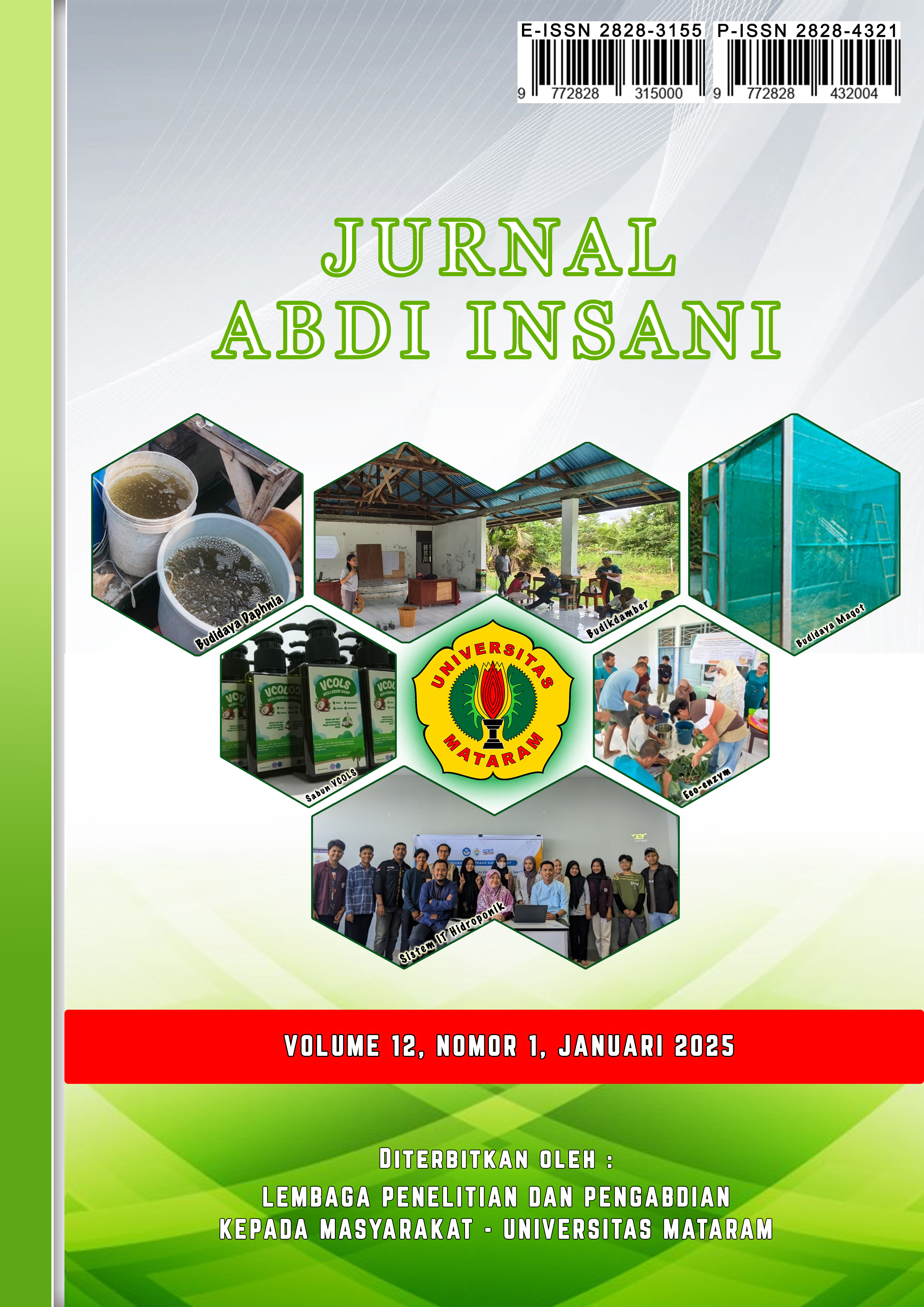PROGRAM PENGEMBANGAN CURUG MUNTU SEBAGAI PENGUATAN PROGRAM EKOWISATA DI DESA KETENGER, KECAMATAN BATURRADEN, KABUPATEN BANYUMAS – PEMBERDAYAAN KEMITRAAN MASYARAKAT
DOI:
https://doi.org/10.29303/abdiinsani.v12i1.2268Keywords:
Pengembangan Curug Muntu, Penguatan Program Ekowisata, Pemberdayaan Kemitraan Masyarakat.Abstract
Curug Muntu Development Program in Ketenger Village, Baturraden District, Banyumas Regency, aims to strengthen ecotourism in the area. Curug Muntu, which is known as a natural tourist attraction, has great potential to support the local economy and increase awareness of environmental conservation. So far, Curug Muntu has not been used as an ecotourism destination in Ketenger village because its condition still needs to be managed. Its existence is different from the two waterfalls that have been managed as tourist destinations, namely Curug Jenggala and Curug Bayan. This development involves empowering local communities through partnerships, which is expected to improve infrastructure, increase tourism service capacity, and provide direct economic benefits to village residents. This program is part of a larger effort to develop tourism potential in Banyumas and promote sustainable ecotourism. Through training and practice during the community service program, the community succeeded in creating infrastructure leading to and at Curug Muntu, increasing the capacity of tourism services by creating social media to promote Curug Muntu, and opening up employment opportunities for the surrounding community. With the introduction of social media platforms such as Instagram, Facebook, and TikTok, Curug Muntu is starting to become widely known, which is marked by an increase in tourist visit.
Downloads
References
Aletta, D. M., Palupiningtyas, D., & Adhistyo, T. (2024). Pendampingan Manajemen Dasar-dasar Pariwisata untuk Keberlanjutan dan Pengembangan Produk Destinasi Wisata. NUSANTARA Jurnal Pengabdian Kepada Masyarakat, 4(3), 95–103. https://doi.org/10.55606/nusantara.v4i3.3086
Anup, K. C. (2017). Ecotourism in Nepal. The Gaze: Journal of Tourism and Hospitality, 8, 1–19. https://doi.org/10.3126/gaze.v8i0.17827
Ekawaty, D., Julian, M., S.H., M. M. N., & Fahreza, G. (2024). Homestay Tourism as Tourism Development in Pemuteran Traditional Village. Barista : Jurnal Kajian Bahasa Dan Pariwisata, 11(01), 1–11. https://doi.org/10.34013/barista.v11i01.1472
Sarifah, F., Herianto, Nurhayati, N., & Saepulmilah, C. (2024). Recommendations for Ecotourism Potential Development of Cidanti Lake, Gunungsari Village, Cikatomas Subdistrict, Tasikmalaya Regency, West Java Province. ABDIMAS: Jurnal Pengabdian Masyarakat, 7(1), 75–85. https://doi.org/10.35568/abdimas.v7i1.4182
Gura, D., Kiryunikova, N., Lesovaya, E., & Pshidatok, S. (2020). Barrier-free environment as an aspect for the development of accessible ecotourism. E3S Web of Conferences, 175, 10013. https://doi.org/10.1051/e3sconf/202017510013
Khatiwada, S. S. (2022). Ecotourism Practice with Community Based Home-stay Program in the Gandaki Province of Nepal. FORMATH, 21(0), 21.001. https://doi.org/10.15684/formath.21.001
Ota, T., Lonn, P., & Mizoue, N. (2021). Contribution of Community-Based Ecotourism to Forest Conservation and Local Livelihoods. In Decision Science for Future Earth (pp. 197–207). Springer Singapore. https://doi.org/10.1007/978-981-15-8632-3_9
Rema, R., & Karunakaran, N. (2018). Ecotourism Development and its Economic Impacts on Local Population in India. International Journal of Advanced Multidisciplinary Scientific Research, 1(6), 17–20. https://doi.org/10.31426/ijamsr.2018.1.6.612
Runtiko, A. G., Rahayu, D. B. S., Santoso, E., & Khusna, I. H. (2021). Pemberdayaan Perempuan Melalui Praktik Jurnalisme Warga Berbasis Media Sosial. Darma Sabha Cendekia, 3(3), 117–123.
Runtiko, A. G., Rosyadi, S., Yamin, M., & Syarif Hidayat, A. (2024). Social Media as A Strategic Communication Tool in The Development and Promotion of Ecotourism (The Case of a Small and Medium Ecotourism Enterprise in Pangalengan, West Java). Sodality: Jurnal Sosiologi Pedesaan, 11(2), 206–222. https://doi.org/10.22500/11202347603
Stem, C. J., Lassoie, J. P., Lee, D. R., Deshler, D. D., & Schelhas, J. W. (2003). Community Participation in Ecotourism Benefits: The Link to Conservation Practices and Perspectives. Society & Natural Resources, 16(5), 387–413. https://doi.org/10.1080/08941920309177
Sukmaniara, M. (2022). Exploring Strategies to Improve The Service Quality of Food in Community-Based Ecotourism: A Case Study of Trapeang Sangke Community-Based Ecotourism, Kampot Province. Sociae Polites, 23(1), 277–294. https://doi.org/10.33541/sp.v23i1.4113
Tina, T., Sipayung, L. D. V., & Donargo, S. (2024). Instagram Utilization in Promoting Ecotourism in Pari Village, Pantai Cermin District, Serdang Bedagai Regency. International Journal of Economics and Management, 2(02), 172–183. https://doi.org/10.54209/iem.v2i02.40
Tiwari, S., Marahatta, D., & Devkota, H. (2024). Aspects of Community Participation in Eco-tourism: A Systematic Review. Journal of Multidisciplinary Research Advancements, 2(1), 71–79. https://doi.org/10.3126/jomra.v2i1.66650
Wiyono, S. H., Subianto, A., & Nuhman, N. (2023). Sustainable Ecotourism Development and Community Empowerment: A Case Study of the Center for Environmental Education in Seloliman Village, Indonesia. Society, 11(2), 310–328. https://doi.org/10.33019/society.v11i2.528




















